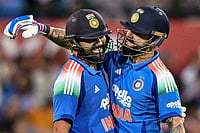Humiliation can sometimes act as a spur that changes the course of story. The historyof India as a nation was shaped by a man who was ejected out of a train in colonial,racist South Africa. And a spark in its cricketing history was perhaps lit during itslowest moment cricket, the thrashing it received in England in 1974.
There is an apocryphal story that a 15 year-old boy following those games from backhome felt so upset at India's defeat that he vowed to avenge it one day. India's spinquartet had failed them on that tour; England's pace had swung the series. Kapil DevRamlal Nikhanj decided then that pace bowling would be his vocation, and that a time wouldcome when India would win matches through his fast bowling.
This was an audacious conception. Consider that India hadn't had genuine pace bowlerssince Mohammad Nissar and Amar Singh in the '30s, and since Kapil had been born, in 1959,Indian new-ball bowlers existed only to take the shine off for the spinners. Fast bowlingwas alien to India's cricketing culture; pace, like pre-marital sex, was just not Indian.
This is beautifully illustrated by a story that has since become part of legend, of anunder-19 camp that Kapil attended sometime in the mid-70s. For lunch, he was given onlytwo chapatis and a spoonful of vegetables. When he protested, saying that a fast bowlerneeded more nutrition, the administrator present, Keki Tarapore, laughed at him and toldhim, "There are no fast bowlers in India." Humiliation, again. And a spark.
Kapil made his Test debut in Pakistan in 1978, in Faisalabad, and it was dear, rightaway, that he was special. He didn't shuffle a few paces and turn his arm over; his smoothathletic run-up and easy action generated a pace that prompted opener Sadiq Mohammad todiscard his cap for a helmet; a decision justified by what happened one over later, when asnorter Tom Kapil hit Sadiq on the helmet and rushed off for four byes.
The spin quartet was on the wane when Kapil entered Test cricket, but it was skillinconceivable that India's main strike bowler would one day be this happy accident, agenuine paceman. But a corroboration of that inevitability came in Kapil's seventh Test,and the first India won since his advent, against West Indies in Madras in January 1979, aweek after Kapil turned 20.
The Chepauk had the fastest pitch in India, and Wisden Cricketers' Almanackdescribed the match as a "bumper-war," in which the Indians "gave as goodas they got." Sylvester Clarke, Norbert Phillip and Vanburn Holder peppered theIndians with bouncers, and Kapil and his new-ball partner, Karsan Ghavri, responded inkind. The West Indians had to duck and weave as much as the Indians did, and eventuallysuccumbed as India won by three wickets. Kapil took seven wickets in the match, Ghavritook four; it was the first Test win in India's history where the spinners hadn't takenthe bulk of the wickets.
Kapil's explosive batting also marked him out. India had never seen a counter attackerlike him; there was no diffidence in his batting, just an earthy desire to thwack the ballout of whichever park the game was being played in, and the rare ability to do so. Hisclassic 175 not out against Zimbabwe in the 1983 World Cup, his four consecutive sixesagainst Eddie Hemmings at Lord's in 1990 to avoid the follow-on, the eight Test centurieshe made, most of them in a crises, all stand testimony to a raw, uninhibited talent thatwas never fully realised.
The cricket Kapil played was an extension of his personality: ebullient, zestful,unrestrained. If Gavaskar was the brains of Indian cricket, Kapil was the heart; andIndian cricket needed them both. When Gavaskar captained India, he would try, in thefinest tradition of Bombay captains, to make sure a match was safe before he went for thewin. Kapil would just throw himself into the thick of things and go for broke. He liked tosay that he did not believe in theory, but inaction on the field. He downplayed strategy,perhaps his only shortcoming as a captain, but no-one could deny he led from the Font.
The embodiment of the difference he made to Indian cricket was the 1983 World Cup. Init, he inspired a team that looked far from extraordinary on paper to lift themselves andplay out of their skins, as a cohesive unit that believed in the audacious conception - afamiliar phrase -that it could actually win the cup, ahead of the seemingly impregnableWest Indies. He led by example, bowling, batting and fielding at the top of his form, andIndia won, an achievement that stands as an inspiration to future generations, and as amonument to what Indian cricket is capable of at its best. Kapil Dev was its architect.
Amit Varma is Assistant Editor of Wisden Asia Cricket magazine


























